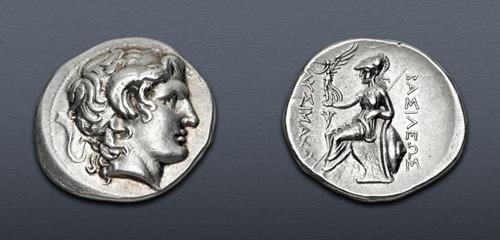|
KINGS of THRACE, Macedonian. Lysimachos. 305-281 BC. AR Tetradrachm (28.5mm, 16.88 g, 1h). Sestos mint. Struck 297/6-282/1 BC. Diademed head of the deified Alexander right, with horn of Ammon / Athena Nikephoros seated left, arm resting on shield, transverse spear in background; flower to inner left. Thompson 29; Müller 331; HGC 3, 1750 corr. (mint missing from list). Lightly toned, minor die rust on obverse. Good VF.
From the G. Savonarola Collection. Ex Classical Numismatic Group 82 (16 September 2009), lot 342.
Lysimachos, a Macedonian noble of great strength and stature, was born circa 360 BC and rose to prominence as a bodyguard for Alexander the Great, although he was a generation older than the young king. When Alexander’s territories were parceled out in 323 BC, Lysimachos was given control of Thrace, the Chersonese, and the intervening Black Sea coast. Much of this territory was claimed by various Thracian tribes, forcing him to spend decades in a largely fruitless effort to subdue them. By the time he assumed the royal title in 306/5 BC, his kingdom consisted of little more than the southern portions of Thrace. But he soon experienced a late-career revival as he plunged fully into the wars of the Diadochi, carving out an ever-expanding realm largely at the expense of his main rivals, Antigonos I Monophthalmos and his son Demetrios I Poliorketes. This territory was rich with both bullion and mint cities, enabling Lysimachos to begin striking a voluminous coinage on his behalf, initially patterned on the coins of Alexander, but with his own name and royal title. In 297 BC, he introduced a new type whose iconography would resound through the ages. The obverse was a portrait of the deified Alexander, diademed and bearing a ram’s horn sprouting from his temples, symbolic of the hybrid Greco-Egyptian god Ammon. This undoubtedly refers to one of the most famous episodes in Alexander’s legendary life, his visit to the shrine of Ammon in the Egyptian oasis of Siwa, in which the oracle greeted him as ‘my son.’ The reverse depicted Athena, Lysimachos’ patron goddess, seated on a massive throne and resting her arm on a shield. This vision of the seated warrior-goddess proved enduring and can still be seen as the figure of Britannia on modern coins. Dozens of mints produced Lysimachos types in both silver and gold, and would continue to do so for decades after his own battlefield demise in 281 BC at the ripe age of 79. The range of styles varies greatly by mint, ranging from highly idealized to stunningly lifelike. G.K. Jenkins noted the power of the Alexander portrait in his commentary on the Gulbenkian Collection: “ [T]he best of the Alexander heads on Lysimachos’ coinage...have a power and brilliance of effect that is irresistible. It [is speculated] that these Alexander heads may have derived from an original gem carved by Pyrgoteles, an engraver prominent among the artists of Alexander’s court....” Regardless of the inspiration, part of the remarkable attraction of this coinage is its artistic variety, with each engraver creating his own fresh and distinctive portrayal of the world’s greatest conqueror.
The final winners of all CNG Feature Auction 129 lots will be determined during the live online sale that will be held on 13-14 May 2025. This lot is in Session One, which will begin 13 May at 9 AM ET.
Winning bids are subject to a 22.5% buyer's fee for bids placed on this website and 25% for all others.
We recognize that our users may have various Internet Browsers and Operating Systems. We like our visitors to have the best possible experience when using our bidding platform. However, we do recognize that it is impossible to develop applications that work identically, efficiently and effectively on all web browsers. The CNG bidding platform supports the latest stable major version and stable previous version of Chrome and Firefox.
|
